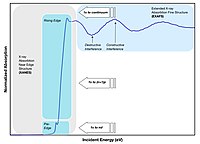
Photo from wikipedia
The molecular arrangement of vacuum thermally deposited polycrystalline Zn-phthalocyanine (ZnPc) layers on Si substrates is investigated using near-edge X-ray absorption fine-structure (NEXAFS) spectroscopy in the proximity of the carbon edge… Click to show full abstract
The molecular arrangement of vacuum thermally deposited polycrystalline Zn-phthalocyanine (ZnPc) layers on Si substrates is investigated using near-edge X-ray absorption fine-structure (NEXAFS) spectroscopy in the proximity of the carbon edge at E0 = 287.33 eV. The data were collected as a function of the deposition substrate temperature TS (30, 90, 150°C) and the incidence angle θ (20°, 45°, 70°, 90°) of the synchrotron beam with respect to the sample plane. Each spectrum was analysed by mathematical simulation applying an error function for the carbon edge and a set of Voigt and (asymmetric) Gaussian functions for C1s → π* and C1s → σ* transitions of ZnPc, respectively. It turned out that part of the organic layer consists of adventitious carbon, which does not contribute to the molecular transitions of ZnPc, whereas all molecular features exhibit polarization-dependent peak areas pointing to a reasonable fraction of well-assembled molecules at any TS. The highest adventitious carbon fraction was found at TS = 30°C, whereas the highest polarization dependence was found at TS = 90°C. The calculated average molecular tilt angles for the three temperatures (30, 90, 150°C) were γ = 60.6°, 68.7° and 66.7°, respectively. If only the polarization-dependent fractions are considered, then the three samples can be mathematically described using a shared molecular tilt angle of γ = 68.7°, which corresponds to the average tilt angle of the TS = 90°C sample.
Journal Title: Journal of synchrotron radiation
Year Published: 2019
Link to full text (if available)
Share on Social Media: Sign Up to like & get
recommendations!